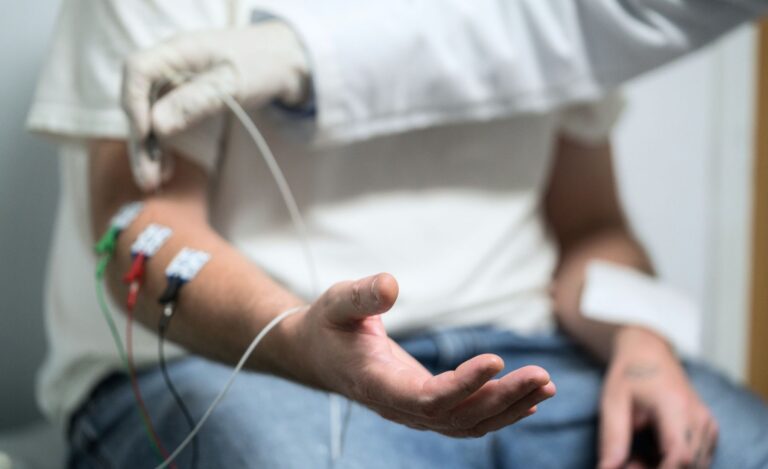In America, nearly 100 million people are affected by a nerve disorder or neurological disorder. Nerve disorders affect the nervous system, which controls the brain, spine, nerves, muscles, and other bodily functions. This can affect quality of life, lifespan, body movements, cognitive processing, thoughts and perception, and more.
Catching common nerve disorders early can help patients improve their quality of life before the condition worsens. By identifying a nerve disorder early, patients can get help to change daily habits to improve their health and slow the progression of the disorder.
Knowing common nerve disorders and their neurological symptoms can help with early detection, doctor’s visits, and medical interference when you need it most.
Note: Content on neuromedpa.com is not doctor’s advice and should not be taken as such. Always contact your primary care doctor for medical services, diagnosis, treatment, and more.
Common Nerve Disorders in Adults
Migraine Headaches
Migraine headaches are one of the most common nerve disorders. This is because headaches may be classified as migraines, tension headaches, cluster headaches, and more.
Migraine headaches are not always a sign of an underlying nerve disorder that needs treatment. Headaches may be caused by stress, pinched nerves, muscle tension, clenched jaw, and more. However, some migraine headaches can be due to an underlying condition and should receive medical treatment.
When should I see a doctor for migraine headaches? Migraine headaches may be a sign of a larger nerve disorder if they are common, come on suddenly, are accompanied by a fever, or happen frequently. If you find you are consistently taking medications for headache prevention, you may need to talk to your doctor about further testing to identify the underlying condition.
Neurologists can help treat headaches with medications, holistic treatments, physical therapy, and other modalities that target the underlying issue.
Stroke
In America, almost 800,000 people are affected by a stroke each year. Strokes can be extremely difficult to spot in the first few moments and can have catastrophic effects when they are severe. This is why stroke prevention is so important for patients who are at high risk of strokes and getting carotid doppler ultrasounds can help determine someone’s likelihood of having a stroke.
It’s important to BE FAST when it comes to spotting a stroke:
- Balance: Sudden loss of balance or coordination
- Eyes: Blurred vision, double vision, or sudden loss of vision
- Face: Drooping or face numbness
- Arm: Weakness or numbness in arms or legs on one side of the body
- Speech: Slurred speech, difficulty understanding their speech, or unable to speak
- Time: Strokes happen quickly, time is important! Call 911 right away and seek emergency help
If you are concerned you see someone having a stroke, always call 911 immediately and seek emergency help. Talking to your doctor about the risk factors of a stroke and what you can do to prevent a stroke can go a long way to staying healthy.
If you have suffered a stroke, a neurologist can help with stroke recovery and care. Neurologists can provide medications, physical therapy, and nerve treatments to help recover mobility, function, stability, and more following a stroke.

Seizures and Epilepsy
Over 3 million people across the country have active epilepsy – and 1 in 26 people will be diagnosed with a form of epilepsy in their lifetime.
Epilepsy is a chronic brain disorder that causes unprovoked seizures. Patients are most often diagnosed with epilepsy vs a seizure disorder when they have two seizures without cause in a 24 hour period. Diagnosis for epilepsy can include various tests including blood tests, MRIs, CTs, and EEGs.
For patients with epilepsy, life can be difficult due to uncontrollable body movements, unpredictable loss of consciousness, and sudden changes in emotion, mood, or awareness.
To spot epilepsy, you want to look for common signs of a seizure. These are not always dramatic fainting spells, convulsions, or loss of consciousness. A seizure may look like:
- Staring spells or abnormal eye movements
- Difficulty speaking
- Drooling
- Stopped breathing
- Loss of bladder and bowels
- Sudden onset of panic before a seizure symptom
- Feeling dizzy, irritated, scared, frustrated, or nervous before the onset of a seizure
The good news is that neurologists can help treat common neurological disorders like epilepsy and seizures. For most adults, one anti-seizure medication can stop the seizures. For other patients, a regimen of medications can help lessen the effects or frequency of the seizures. Some patients with epilepsy are able to get off their medications entirely after a few years.
Parkinson’s Disease
Considered the second most common neurodegenerative disease in the US, Parkison’s disease affects roughly 1 million Americans. It is most commonly known as causing tremors, primarily in the hands. However, Parkison’s disease can also cause difficulty walking, problems with talking, stiffness, loss of balance and coordination, anxiety, hallucinations, sleep disorders, and loss of smell.
To spot Parkison’s disease early, look for signs of tremors in a single hand, foot, or even the jaw. Stiffness, slow movement, and impaired balance and coordination are also other common signs. A neurologist can provide a diagnosis of Parkison’s disease and help with treatments including medications, physical therapy, dietary recommendations, speech therapy, and more.
Parkison’s is most common in people over the age of 60 and is a disease that worsens over time. Noticing the signs of Parkison’s disease early and seeking treatment for a common neurological disorder can help protect quality of life and slow the progression.

Dementia and Alzheimer's
Known as the most common neurodegenerative disease, Alzheimer’s and dementia are two conditions that affect the brain. When the brain fails, a person’s behavior, emotions, memory, perception, and thinking are all affected.
Dementia includes many diseases that affect brain function, while Alzheimer’s is a type of dementia and primarily affects memory; it is the most common cause of dementia.
To spot dementia and Alzheimer’s early, patients are advised to look for:
- Memory loss, short-term or long-term
- Confusion
- Getting lost
- Speech and communication issues
- Dramatic mood changes
- Paranoia
- Withdrawing from social activities
- Having poor judgment
While there is no cure or reversal for dementia and Alzheimer’s, a neurologist can help with diagnosis and treatment to protect quality of life. Visiting a neurologist for common neurological disorder treatment for Alzheimer’s can include medications, physical therapies, tracking the disease progression, support groups for caregivers, and recommendations for quality of life.
Multiple Sclerosis
Almost 1 million people in the US are diagnosed with multiple sclerosis (MS). It is most common in women vs men and is often diagnosed between ages 20 and 40.
MS is an autoimmune disease that damages the protective coating around the nerves. This can cause blurred vision, balance issues, overall weakness, tingling in the limbs, and fatigue. To spot MS early and seek neurological intervention, it is advised to look for:
- Double or blurred vision
- Balance issues
- Weakness in the limbs
- Numbness or tingling
- Facial pain
- Limb spasms
- Slurred speech
- Fatigue
- Electric shock sensations
While there is no cure for MS, a neurologist who handles common nerve disorders can help with treatment, quality of life, progression tracking, and support. Treatment for nerve pain related to MS includes fast recovery after MS attacks, reducing the severity and frequency of relapses, and slowing the progression of the disease.
MS can be managed, like most common nerve disorders, with dietary changes, medications, stress reducers, lifestyle changes, and physical therapy. A neurologist can provide personal recommendations for MS treatment following a diagnosis and perform nerve testing for diagnosis and disease progression tracking.

Peripheral Neuropathy
Peripheral neuropathy is a disease that damages the nerves outside of the brain and spinal cord. It affects between 2-7% of the population, particularly those over the age of 50, and is more common in patients with diabetes.
Symptoms of peripheral neuropathy include numbness and tingling, especially in the hands and feet; balance issues; muscle weakness; coordination issues. To spot peripheral neuropathy early, patients are advised to look for:
- Tingling or numbness in the hands or feet, especially at night
- Prickling or burning sensations
- Walking pain
- Muscle weakness in the limbs
- Slower response to temperature changes
- Balance issues
Peripheral neuropathy treatment is all about managing the disease and the underlying cause. A neurologist may recommend an exercise or daily activity schedule, dietary changes, medications, supportive shoes along with other quality of life changes, and preventive injury recommendations.
Be Aware of Common Nerve Disorders
Most nerve disorders do not have cures but do have preventive measures that can be taken along with treatments for quality of life. Spotting the signs of common nerve disorders early and visiting your primary care doctor or a neurologist near you can help prevent the disease from worsening.
With professional treatments like medications, disease tracking, dietary adjustments, and activity recommendations, nerve disorders do not have to completely change your life. Patients and caregivers alike can learn how to live with the disease, manage the disease, and take control of their life.
Get a consult for adult treatment of common nerve disorders at Neurological Medicine in Maryland.

Frequently Asked Questions
What are the most common nerve disorders?
Some of the most common nerve disorders include peripheral neuropathy, multiple sclerosis, epilepsy, and dementia. Each condition impacts the nerves differently and requires specific treatments.
What causes nerve disorders?
Nerve disorders can be caused by diabetes, injuries, infections, autoimmune diseases, vitamin deficiencies, toxins, or genetic factors. Sometimes, the cause is unknown or is related to old age.
What are the common symptoms of nerve disorders?
Symptoms of most common nerve disorders often include numbness, tingling, burning pain, weakness, or loss of reflexes. These vary depending on the type of nerve affected.
How are nerve disorders diagnosed?
Doctors use physical exams, nerve conduction studies, electromyography, and imaging tests like MRIs to diagnose nerve disorders. Blood tests may also identify underlying issues.
Can nerve disorders be treated or cured?
Many nerve disorders cannot be cured but do have treatments to improve quality of life and slow the progression of the disease. Treatment options include medications, physical therapy, lifestyle changes, or surgery. While some conditions can be managed or cured, others require long-term care.
Are nerve disorders preventable?
Preventative steps for common nerve disorders include controlling blood sugar, avoiding repetitive motions, and ensuring proper vitamin intake. However, some genetic or autoimmune-related disorders are unavoidable.
When should I see a doctor for nerve-related issues?
See a doctor if you experience persistent numbness, weakness, or symptoms interfering with daily life. Early diagnosis can improve treatment outcomes.

Neurological Medicine, P.A.
Neurological Medicine, P.A., provides comprehensive diagnostic and treatment services to patients with conditions affecting the brain, spinal cord, nerves, and muscles. We have been serving the Prince George’s and Montgomery County area since 1975, with two offices: Greenbelt and Laurel. We offer complete adult neurological care as well as in-office neurodiagnostic studies.
- Neurological Medicine, P.A.#molongui-disabled-link
- Neurological Medicine, P.A.#molongui-disabled-link
- Neurological Medicine, P.A.#molongui-disabled-link
- Neurological Medicine, P.A.#molongui-disabled-link



